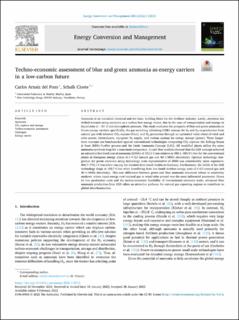| dc.contributor.author | Arnaiz del Pozo, Carlos | |
| dc.contributor.author | Cloete, Schalk Willem Petrus | |
| dc.date.accessioned | 2022-08-08T08:56:34Z | |
| dc.date.available | 2022-08-08T08:56:34Z | |
| dc.date.created | 2022-05-19T12:21:27Z | |
| dc.date.issued | 2022 | |
| dc.identifier.citation | Energy Conversion and Management. 2022, 255 1-17. | en_US |
| dc.identifier.issn | 0196-8904 | |
| dc.identifier.uri | https://hdl.handle.net/11250/3010564 | |
| dc.description.abstract | Ammonia is an industrial chemical and the basic building block for the fertilizer industry. Lately, attention has shifted towards using ammonia as a carbon-free energy vector, due to the ease of transportation and storage in liquid state at −33 °C and atmospheric pressure. This study evaluates the prospects of blue and green ammonia as future energy carriers; specifically, the gas switching reforming (GSR) concept for H2 and N2 co-production from natural gas with inherent CO2 capture (blue), and H2 generation through an optimized value chain of wind and solar power, electrolysers, cryogenic N2 supply, and various options for energy storage (green). These longer-term concepts are benchmarked against conventional technologies integrating CO2 capture: the Kellogg Braun & Root (KBR) Purifier process and the Linde Ammonia Concept (LAC). All modelled plants utilize the same ammonia synthesis loop for a consistent comparison. A cash flow analysis showed that the GSR concept achieved an attractive levelized cost of ammonia (LCOA) of 332.1 €/ton relative to 385.1–385.9 €/ton for the conventional plants at European energy prices (6.5 €/GJ natural gas and 60 €/MWh electricity). Optimal technology integration for green ammonia using technology costs representative of 2050 was considerably more expensive: 484.7–772.1 €/ton when varying the location from Saudi Arabia to Germany. Furthermore, the LCOA of the GSR technology drops to 192.7 €/ton when benefitting from low Saudi Arabian energy costs (2 €/GJ natural gas and 40 €/MWh electricity). This cost difference between green and blue ammonia remained robust in sensitivity analyses, where input energy cost (natural gas or wind/solar power) was the most influential parameter. Given its low production costs and the techno-economic feasibility of international ammonia trade, advanced blue ammonia production from GSR offers an attractive pathway for natural gas exporting regions to contribute to global decarbonization. | en_US |
| dc.language.iso | eng | en_US |
| dc.publisher | Elsevier | en_US |
| dc.rights | Navngivelse 4.0 Internasjonal | * |
| dc.rights.uri | http://creativecommons.org/licenses/by/4.0/deed.no | * |
| dc.subject | Energy carrier | en_US |
| dc.subject | Hydrogen | en_US |
| dc.subject | Techno-economic assessment | en_US |
| dc.subject | CO2 capture and storage | en_US |
| dc.subject | Ammonia | en_US |
| dc.title | Techno-economic assessment of blue and green ammonia as energy carriers in a low-carbon future | en_US |
| dc.title.alternative | Techno-economic assessment of blue and green ammonia as energy carriers in a low-carbon future | en_US |
| dc.type | Peer reviewed | en_US |
| dc.type | Journal article | en_US |
| dc.description.version | publishedVersion | en_US |
| dc.rights.holder | © 2022 The Author(s). Published by Elsevier Ltd. | en_US |
| dc.source.pagenumber | 1-17 | en_US |
| dc.source.volume | 255 | en_US |
| dc.source.journal | Energy Conversion and Management | en_US |
| dc.identifier.doi | 10.1016/j.enconman.2022.115312 | |
| dc.identifier.cristin | 2025581 | |
| dc.source.articlenumber | 115312 | en_US |
| cristin.ispublished | true | |
| cristin.fulltext | original | |
| cristin.qualitycode | 1 | |

